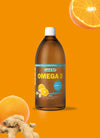Omega 3 Liquid Supplement 500 ml | Orange & Ginger
Regular price
$53.49
Sale price
$59.49
New label, same formula!
Liquid fish oil supplement made with premium extra virgin oil. All natural and free from preservatives.
NPN: 80005656
General
Land Art Omega-3 Liquid Supplement helps support cardiovascular and cognitive health. Our Land Art fish oil is a product of exceptional quality.
First of all, our oil is sourced from small wild fish (anchovies, sardines and mackerel), fished responsibly in non-polluted fishing zones.
Contrary to the majority of omega-3 supplements, no chemical solvents were used.
Land Art's omega-3 formula is great for the whole family. It has a natural AEP / DHA ratio of 18% and 12%. Free of preservatives, our omega-3 supplement is available in a natural orange and ginger flavor.
* Available in 250 ml and 500 ml formats.
Required dosage for specific needs
| Needed benefit | Omega-3 required dosage | Ideal EPA:DHA ratio | Equivalent Land Art liquid Omega-3 dosage | Equivalent Land Art softgels dosage(500 mg) |
| Helps maintain/support cardiovascular health. | Between 500 and 3000 mg | Between 0.5:1 and 2:1 | 5 ml | 2 |
| Helps to reduce serum triglycerides/triacylglycerols. | Between 2800 and 3000 mg | Between 0.5:1 and 2:1 | 15 ml | 6 |
| Helps to reduce the pain of rheumatoid arthritis in adults (in conjunction with conventional therapy). | Between 2800 and 3000 mg | Between 0.5:1 and 2:1 | 15 ml | 6 |
| Helps support cognitive health and/or brain function. | Between 100 and 3000 mg | Minimum 100 mg DHA | 5 ml | Min. 4 |
| Helps support the development of the brain, eyes and nerves in children up to 12 years of age. | Between 150 and 2000 mg | Minimum 100 mg d'ADH | 5 ml | Min. 6 |
| Helps to promote healthy mood balance. | Between 1500 and 3000 mg | Minimum 1000 mg EPA | 10 ml | 12 |
Source Sante Canada
Benefits
Omega-3s are generally known to:
- Help cognitive health and cerebral functions;
- Reduce certain risk factors for cardiovascular disease and decrease the risk of a recurrent heart attack;
- Contribute to the development of the brain, the eyes and nerves in children and adolescents;
- Promote the neural development of the fetus;
- Have an impact on mood and decrease symptoms of depression.
Dosage
Dosage and how to use
- Children and adolescents (1 to 17 years old): 1 teaspoon (5 ml) per day.
- Adults (18 years and older): 2 teaspoons (10 ml) per day.
* May be diluted in a glass of juice or water.
Expiration and conservation
Preservative free. To avoid contaminating the product, do not drink directly from the bottle. Keep refrigerated after opening.
Precautions and warnings
- Do not use if the security seal is broken.
- Keep out of the reach of children.
- Shake well before use.
- Keep refrigerated after opening.
Ingredients
Medicinal (per 5 ml)
- Fish oil (18 % EPA, 12 % DHA), 4620 mg, sourced from anchovies, sardines and mackerel
- Total Omega-3 fatty acids, 1380 mg
- EPA (eicosapentaenoic acid), 830 mg
- DHA (docosahexaenoic acid), 550 mg
Non-Medicinal
- Natural ginger and orange aroma, rosemary extract, vitamin E.
* Does not contain preservatives, dairy products, wheat, gluten, yeast or corn, or sodium.
Recipes
Although Land Art’s Omega 3 has a delightful taste, certain people may not appreciate the oily texture.
Here are a few suggestions:
- Add the required dose to a salad dressing and incorporate it into a salad.
- Add it to a piece of bread.
- Add it into yogurt or a smoothie.
FAQ
Although the efficiency of marine sourced Omega-3s is well established, vegetable sourced Omega-3s have not been sufficiently studied. However, we know with certainty that only marine sources supply a direct source of eicosapentaenoic acid (EPA) and docosahexaenoic acid (DHA), the two fatty acids responsible for the therapeutic benefits of Omega-3s.
Vegetable sources, however, they contain alpha-linolenic acids (ALA), substances that the body transforms into EPA and DHA, although the action is limited (the conversion rate of ALA into EPA and DHA is less than 1% in humans). Diabetes, excessive use of alcohol, smoking and stress may all lead to difficulty or the inability to transform ALA.
About balanced Omega-3 / Omega-6 ratios
Consuming fish is less popular and industrial products containing Omega-6s have increased, thereby creating unbalance between the Omega-3/Omega-6 ratios. As both compete with each other, excessive Omega-6 is detrimental to the maximum efficiency of Omega-3 in the body. In order to be metabolized, Omega-3s and Omega-6s must compete for different enzymes, vitamins (vitamins B3, B6, C, E) and minerals (magnesium and zinc).
Excess consumption of Omega-6s can actually block the benefits of Omega-3s, notably on a the cardiovascular protection level. Too much Omega-6 may also provoke pain and inflammatory diseases such as asthma or arthritis.
It is estimated that the ratio of omega-6/omega-3 in the occidental diet is generally from 10/1 to 30/1 when it should ideally be between 1/1 and 4/1. Supplements containing Omega-6 should therefore be avoided.
Do all omega-3s have the same properties?
Beware of other Omega-3 supplements. Most of them contain higher artificial ratios of EPA/DHA and boast about higher omega-3 levels. This means that chemical solvents and very high temperatures were used during fabrication in their laboratories. This intervention has detrimental effects because the natural molecular structure of the fish oil is destroyed. These artificial oils clog up our liver because our body must process them before using them. Many people develop an intolerance to these types of artificial oils that lead to eczema, digestive problems, etc. In conclusion, look for fish oils with a natural ratio of 18 % and 12 % EPA/DHA.
A higher quantity of omega-3 is not proof of quality!








 Made in Canada
Made in Canada













